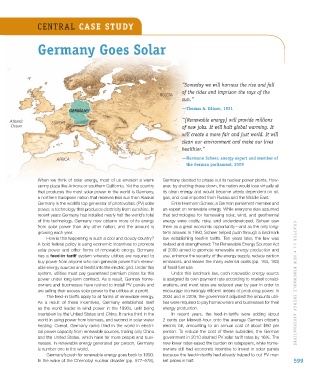Page 600 - Environment: The Science Behind the Stories
P. 600
CENTRAl CAsE stUdy
Germany Goes solar
“Someday we will harness the rise and fall
of the tides and imprison the rays of the
RUSSIA
sun.”
—thomas A. Edison, 1921
GERMANY
Atlantic EUROPE “[Renewable energy] will provide millions
Ocean of new jobs. It will halt global warming. It
will create a more fair and just world. It will
clean our environment and make our lives
healthier.”
AFRICA — Hermann scheer, energy expert and member of
the German parliament, 2009
When we think of solar energy, most of us envision a warm Germany decided to phase out its nuclear power plants. How-
sunny place like Arizona or southern California. Yet the country ever, by shutting these down, the nation would lose virtually all
that produces the most solar power in the world is Germany, its clean energy and would become utterly dependent on oil,
a northern European nation that receives less sun than Alaska! gas, and coal imported from Russia and the Middle East.
Germany is the world’s top generator of photovoltaic (PV) solar Enter Hermann Scheer, a German parliament member and
power, a technology that produces electricity from sunshine. In an expert on renewable energy. While everyone else assumed
recent years Germany has installed nearly half the world’s total that technologies for harnessing solar, wind, and geothermal
of this technology. Germany now obtains more of its energy energy were costly, risky, and underdeveloped, Scheer saw
from solar power than any other nation, and the amount is them as a great economic opportunity—and as the only long-
growing each year. term answer. In 1990, Scheer helped push through a landmark
How is this happening in such a cool and cloudy country? law establishing feed-in tariffs. Ten years later, the law was
A bold federal policy is using economic incentives to promote revised and strengthened: The Renewable Energy Sources Act
solar power and other forms of renewable energy. Germany of 2000 aimed to promote renewable energy production and
has a feed-in tariff system whereby utilities are required to use, enhance the security of the energy supply, reduce carbon
buy power from anyone who can generate power from renew- emissions, and lessen the many external costs (pp. 164, 183)
able energy sources and feed it into the electric grid. Under this of fossil fuel use.
system, utilities must pay guaranteed premium prices for this Under this landmark law, each renewable energy source
power under long-term contract. As a result, German home- is assigned its own payment rate according to market consid-
owners and businesses have rushed to install PV panels and erations, and most rates are reduced year by year in order to CHAPTER 21 • N E w R ENE wA bl E E NER gy AlTERN AT iv E s
are selling their excess solar power to the utilities at a profit. encourage increasingly efficient means of producing power. In
The feed-in tariffs apply to all forms of renewable energy. 2004 and in 2009, the government adjusted the amounts utili-
As a result of these incentives, Germany established itself ties were required to pay homeowners and businesses for their
as the world leader in wind power in the 1990s, until being energy production.
overtaken by the United States and China. It ranks third in the In recent years, the feed-in-tariffs were adding about
world in using power from biomass, and second in solar water 2 cents per kilowatt-hour onto the average German citizen’s
heating. Overall, Germany ranks third in the world in electri- electric bill, amounting to an annual cost of about $60 per
cal power capacity from renewable sources, trailing only China person. To reduce the cost of these subsidies, the German
and the United States, which have far more people and busi- government in 2010 slashed PV solar tariff rates by 16%. The
nesses. In renewable energy generated per person, Germany new lower rates eased the burden on ratepayers, while home-
is number one in the world. owners still had economic incentive to invest in solar panels
Germany’s push for renewable energy goes back to 1990. because the feed-in-tariffs had already helped to cut PV mar-
In the wake of the Chernobyl nuclear disaster (pp. 577–578), ket prices in half. 599
M21_WITH7428_05_SE_C21.indd 599 12/12/14 4:29 PM

